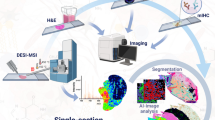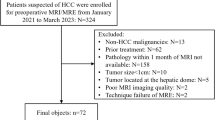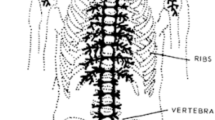Abstract
Objectives
To evaluate the value of ZOOMit diffusion kurtosis imaging (DKI) and chemical exchange saturation transfer (CEST) imaging in predicting WHO/ISUP grade and pathological T stage in clear cell renal cell carcinoma (ccRCC).
Methods
Forty-six patients with ccRCC were included in this retrospective study. All participants underwent MRI including ZOOMit DKI and CEST. The non-Gaussian mean kurtosis (MK), mean diffusivity (MD), magnetization transfer ratio asymmetry (MTRasym (3.5 ppm)), and Ssat (3.5 ppm)/S0 were analyzed based on different WHO/ISUP grades and pT stages. Binary logistic regression was used to identify the best combination of the parameters. Pearson’s correlation coefficients were calculated between CEST and diffusion-related parameters.
Results
The ADC, MD, and Ssat (3.5 ppm)/S0 values were significantly lower for higher WHO/ISUP grade tumors, whereas the MK and MTRasym (3.5 ppm) were higher in higher WHO/ISUP grade and higher pT stage tumors. MTRasym (3.5 ppm) combined with MD (AUC, 0.930; 95% CI, 0.858–1.000) showed the best diagnostic efficacy in evaluating the WHO/ISUP grade. MTRasym (3.5 ppm) and MK were mildly positively correlated (r = 0.324, p = 0.028). Ssat (3.5 ppm)/S0 was moderately positively correlated with ADC (r = 0.580, p < 0.001), mildly positively correlated with MD (r = 0.412, p = 0.005), and moderately negatively correlated with MK (r = −0.575, p < .001).
Conclusion
The microstructural and biochemical assessment of ZOOMit DKI and CEST allowed for the characterization of different WHO/ISUP grades and pT stages in ccRCC. MTRasym (3.5 ppm) combined with MD showed the best diagnostic performance for WHO/ISUP grading.
Key Points
• Both diffusion kurtosis imaging (DKI) and chemical exchange saturation transfer (CEST) can be used to predict the WHO/ISUP grade and pathological T stage.
• MTRasym (3.5 ppm) combined with MD showed the highest AUC (0.930; 95% CI, 0.858–1.000) in WHO/ISUP grading.
• MTRasym at 3.5 ppm showed a positive correlation with mean kurtosis.






Similar content being viewed by others
Abbreviations
- APT:
-
Amide proton transfer
- CEST:
-
Chemical exchange saturation transfer
- DKI:
-
Diffusion kurtosis imaging
- DWI:
-
Diffusion-weighted imaging
- ICC:
-
Intraclass correlation coefficient
- MTRasym (3.5 ppm):
-
Asymmetric magnetization transfer ratio at 3.5 ppm
- ROC:
-
Receiver operating characteristic
- ROI:
-
Region-of-interest
References
Sung H, Ferlay J, Siegel RL et al (2021) Global Cancer Statistics 2020: GLOBOCAN estimates of incidence and mortality worldwide for 36 cancers in 185 countries. CA Cancer J Clin 71:209–249
Escudier B, Porta C, Schmidinger M et al (2019) Renal cell carcinoma: ESMO Clinical Practice Guidelines for diagnosis, treatment and follow-up†. Ann Oncol 30:706–720
Zhao Y, Wu C, Li W et al (2021) 2-[(18)F]FDG PET/CT parameters associated with WHO/ISUP grade in clear cell renal cell carcinoma. Eur J Nucl Med Mol Imaging 48:570–579
Delahunt B, Eble JN, Egevad L, Samaratunga H (2019) Grading of renal cell carcinoma. Histopathology 74:4–17
Zhou H, Mao H, Dong D et al (2020) Development and external validation of radiomics approach for nuclear grading in clear cell renal cell carcinoma. Ann Surg Oncol 27:4057–4065
Demirjian NL, Varghese BA, Cen SY et al (2022) CT-based radiomics stratification of tumor grade and TNM stage of clear cell renal cell carcinoma. Eur Radiol 32:2552–2563
Woo S, Suh CH, Kim SY, Cho JY, Kim SH (2017) Diagnostic performance of DWI for differentiating high- from low-grade clear cell renal cell carcinoma: a systematic review and meta-analysis. AJR Am J Roentgenol 209:W374–w381
Li Q, Cao B, Tan Q, Liu K, Jiang S, Zhou J (2021) Prediction of muscle invasion of bladder cancer: a comparison between DKI and conventional DWI. Eur J Radiol 136:109522
Gao A, Zhang H, Yan X et al (2022) Whole-tumor histogram analysis of multiple diffusion metrics for glioma genotyping. Radiology 302:652–661
Zhang Q, Yu X, Ouyang H et al (2021) Whole-tumor texture model based on diffusion kurtosis imaging for assessing cervical cancer: a preliminary study. Eur Radiol 31:5576–5585
Wang K, Cheng J, Wang Y, Wu G (2019) Renal cell carcinoma: preoperative evaluate the grade of histological malignancy using volumetric histogram analysis derived from magnetic resonance diffusion kurtosis imaging. Quant Imaging Med Surg 9:671–680
Sim KC, Park BJ, Han NY, Sung DJ, Kim MJ, Han YE (2020) Efficacy of ZOOMit coronal diffusion-weighted imaging and MR texture analysis for differentiating between benign and malignant distal bile duct strictures. Abdom Radiol (NY) 45:2418–2429
Yıldırım İO, Sağlık S, Çelik H (2017) Conventional and ZOOMit DWI for evaluation of testis in patients with ipsilateral varicocele. AJR Am J Roentgenol 208:1045–1050
Chen M, Feng C, Wang Q et al (2021) Comparison of reduced field-of-view diffusion-weighted imaging (DWI) and conventional DWI techniques in the assessment of cervical carcinoma at 3.0T: image quality and FIGO staging. Eur J Radiol 137:109557
Li L, Wang L, Deng M et al (2015) Feasibility study of 3-T DWI of the prostate: readout-segmented versus single-shot echo-planar imaging. AJR Am J Roentgenol 205:70–76
Ohno Y, Yui M, Koyama H et al (2016) Chemical exchange saturation transfer MR imaging: preliminary results for differentiation of malignant and benign thoracic lesions. Radiology 279:578–589
Zhou J, Zaiss M, Knutsson L et al (2022) Review and consensus recommendations on clinical APT-weighted imaging approaches at 3T: application to brain tumors. Magn Reson Med 88:546–574
Takayama Y, Nishie A, Togao O et al (2018) Amide proton transfer MR imaging of endometrioid endometrial adenocarcinoma: association with histologic grade. Radiology 286:909–917
Joo B, Han K, Ahn SS et al (2019) Amide proton transfer imaging might predict survival and IDH mutation status in high-grade glioma. Eur Radiol 29:6643–6652
Loi L, Zimmermann F, Goerke S et al (2020) Relaxation-compensated CEST (chemical exchange saturation transfer) imaging in breast cancer diagnostics at 7T. Eur J Radiol 129:109068
Liu R, Zhang H, Niu W et al (2019) Improved chemical exchange saturation transfer imaging with real-time frequency drift correction. Magn Reson Med 81:2915–2923
Liu R, Zhang H, Qian Y et al (2021) Frequency-stabilized chemical exchange saturation transfer imaging with real-time free-induction-decay readout. Magn Reson Med 85:1322–1334
Zhang Y, Heo HY, Lee DH et al (2016) Selecting the reference image for registration of CEST series. J Magn Reson Imaging 43:756–761
Yu X, Lin M, Ouyang H, Zhou C, Zhang H (2012) Application of ADC measurement in characterization of renal cell carcinomas with different pathological types and grades by 3.0T diffusion-weighted MRI. Eur J Radiol 81:3061–3066
Parada Villavicencio C, Mc Carthy RJ, Miller FH (2017) Can diffusion-weighted magnetic resonance imaging of clear cell renal carcinoma predict low from high nuclear grade tumors. Abdom Radiol (NY) 42:1241–1249
Tang L, Zhou XJ (2019) Diffusion MRI of cancer: from low to high b-values. J Magn Reson Imaging 49:23–40
Cao J, Luo X, Zhou Z et al (2020) Comparison of diffusion-weighted imaging mono-exponential mode with diffusion kurtosis imaging for predicting pathological grades of clear cell renal cell carcinoma. Eur J Radiol 130:109195
Zhu J, Luo X, Gao J, Li S, Li C, Chen M (2021) Application of diffusion kurtosis tensor MR imaging in characterization of renal cell carcinomas with different pathological types and grades. Cancer Imaging 21:30
Khor LY, Dhakal HP, Jia X et al (2016) Tumor necrosis adds prognostically significant information to grade in clear cell renal cell carcinoma: a study of 842 consecutive cases from a single institution. Am J Surg Pathol 40:1224–1231
Jones KM, Pollard AC, Pagel MD (2018) Clinical applications of chemical exchange saturation transfer (CEST) MRI. J Magn Reson Imaging 47:11–27
Togao O, Yoshiura T, Keupp J et al (2014) Amide proton transfer imaging of adult diffuse gliomas: correlation with histopathological grades. Neuro Oncol 16:441–448
Adams LC, Ralla B, Jurmeister P et al (2019) Native T1 mapping as an in vivo biomarker for the identification of higher-grade renal cell carcinoma: correlation with histopathological findings. Invest Radiol 54:118–128
Khlebnikov V, Polders D, Hendrikse J et al (2017) Amide proton transfer (APT) imaging of brain tumors at 7 T: the role of tissue water T(1) -Relaxation properties. Magn Reson Med 77:1525–1532
Li A, Xu C, Liang P et al (2020) Role of chemical exchange saturation transfer and magnetization transfer MRI in detecting metabolic and structural changes of renal fibrosis in an animal model at 3T. Korean J Radiol 21:588–597
Acknowledgements
This retrospective study was approved by the Ethics Committee of Tongji Hospital of Huazhong University of Science and Technology. Requirement for informed consent was waived.
Funding
This study has received funding by the National Natural Science Foundation of China (No. 82071889 and 81971605).
Author information
Authors and Affiliations
Corresponding authors
Ethics declarations
Guarantor
The scientific guarantor of this publication is Zhen Li (Department of Radiology, Tongji Hospital, Tongji Medical College, Huazhong University of Science and Technology).
Conflict of interest
The authors of this manuscript declare no relationships with any companies, whose products or services may be related to the subject matter of the article.
Statistics and biometry
No complex statistical methods were necessary for this paper.
Informed consent
Written informed consent was waived by the Institutional Review Board.
Ethical approval
Institutional Review Board approval was obtained.
Methodology
• retrospective
• observational
• performed at one institution
Additional information
Publisher’s note
Springer Nature remains neutral with regard to jurisdictional claims in published maps and institutional affiliations.
Rights and permissions
Springer Nature or its licensor (e.g. a society or other partner) holds exclusive rights to this article under a publishing agreement with the author(s) or other rightsholder(s); author self-archiving of the accepted manuscript version of this article is solely governed by the terms of such publishing agreement and applicable law.
About this article
Cite this article
Li, S., He, K., Yuan, G. et al. WHO/ISUP grade and pathological T stage of clear cell renal cell carcinoma: value of ZOOMit diffusion kurtosis imaging and chemical exchange saturation transfer imaging. Eur Radiol 33, 4429–4439 (2023). https://doi.org/10.1007/s00330-022-09312-2
Received:
Revised:
Accepted:
Published:
Issue Date:
DOI: https://doi.org/10.1007/s00330-022-09312-2




